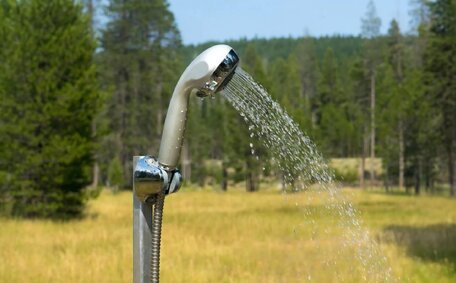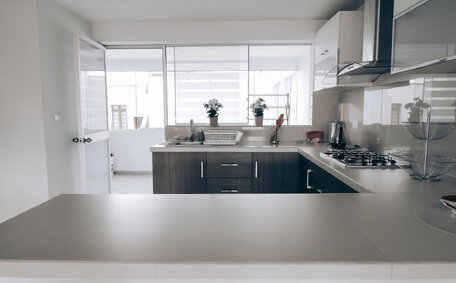Introduction to Hot Water Troubles
Is your hot water suddenly running cold? Experiencing low hot water pressure or no water from your taps can be highly frustrating. As experienced Gladesville plumbers, we recognise the inconvenience of a cold shower or unavailable hot water during crucial times.
Common issues causing these problems are sediment build-up in the hot water system, faulty heating elements, malfunctioning thermostats or thermocouples in gas systems, and obstructed pipes.
Identifying the root cause of why your hot water suddenly goes cold, such as a possible frozen pipe, is key to restoring it.
This guide provides step-by-step troubleshooting to diagnose your home’s hot water delivery issues. We’ll offer solutions to get your hot water back and advise when professional plumbing services are needed.
Assessing Your Faucet and Water Heater
Check your taps and water heater to diagnose the lack of hot water.
Start by performing a check on your cold water tap to ensure your faucet handles are fully turned towards the hot side. Mixer taps can misalign, causing an imbalance between hot and cold water and preventing the water from heating. Rapidly alternating the tap from hot to cold may rectify air locks or loosen obstructions.
Visible faucet defects like leaks suggest wear or mineral build-up, necessitating immediate repairs. Calcium and magnesium build-up may restrict water flow over time. If your faucet shows signs of damage or poor maintenance, you may need to replace washers or cartridges to restore full pressure.
For gas or electric water heaters, ensure the power is on and monitor the water temperature change. Test hot water flow and inspect for leaks at the TPR valve, which may indicate issues like a faulty heating element. Ensure that knobs are turned all the way to prevent minor leaks.
Gas hot water systems may have issues with the pilot light or thermocouple.
Simple heater checks are doable, but complex diagnostics and repairs should be left to our team of skilled licensed plumbers. At Gladesville Plumbing, our team is proficient in servicing tankless water heaters, upkeeping and substituting a variety of hot water setups, including continuous flow tankless water systems.
Checking Valves and Connections
Inspect valves and connections, such as the shutoff valve, to address water supply issues to your heater. Gate valves can seize over time, reducing water pressure and flow to the storage tank.
Ensure it’s fully open to remedy low pressure and improve your heater’s efficiency.
Additionally, examine the water valve flex connectors linked to the hot and cold water pipe lines, as any lack of tightness in faulty ones can result in pressure cold water delivery problems. Tighten any loose fittings, as these could potentially leak your home’s precious hot water and result in intermittent pressure. Check connectors for corrosion and splits which require replacement to restore water pressure.
Annual draining while the heater’s off prevents sediment-related blockages and sustains consistent hot water flow to your fixtures. Doing this flushes the dip tube, which allows water into the system before it gets heated. Water can flow without hindrance once you ensure the drain valves close properly after maintenance.
If you have a gas heater with a heat exchanger, ensure the pilot is lit and supplying a consistent flame to keep the hot water your household needs. Clean any debris that might back up around the gas control valve. If problems persist despite these checks, our team can perform further tests to determine if parts like temperature sensors, heating elements, or thermostats need replacement.
Inspecting Sediment Buildup
Over time, sediment buildup can significantly affect water pressure and is often noticeable in bathroom fixtures.
Debris and mineral deposits can settle at your tank’s bottom, blocking water flow and causing low pressure. If your hot taps often run cold or have low flow, inspect your heater for sediment buildup.
To check for scale and debris accumulation, you’ll first need to switch off power to an electric heater or turn off the gas and pilot light on a gas system. Attach a garden hose to the drain valve at the base of the tank to ensure the draining water then, hot as it may be, is routed to a safe drainage area outside or into your laundry tub. Open the drain valve, flushing for 3-5 minutes to remove sediment from the tank’s bottom.
Be cautious around hot water units to prevent burns; ensure the tank refills safely after maintenance before use. Wear gloves and safety glasses when performing any maintenance. Make sure to close the drain valve properly after ensuring no sediment build up remains, and refill the tank to bring back hot water before restoring power or relighting the pilot.
To maintain optimal performance and prevent hot water loss, flush your heater annually to prevent mineral buildup. If you have extremely hard water, consider installing a whole house water softener system or scale-control fluid tank to reduce sediment. Replacing heating elements and anodes can improve hot water flow.
Common Causes of Inconsistent Hot Water Supply
Sediment Buildup
Sediment from hard water minerals can accumulate at the bottom of your tank over time. Sediment from hard water minerals can accumulate at the bottom of your tank over time. Signs of sediment buildup include cloudy hot water coming tap, rumbling or popping noises, and a reduced flow rate.
Faulty Thermostats
Mechanical or electronic thermostats control hot water tank temperatures.
Malfunctions due to deposits or age can compromise water flow and consistent heating.
Pipe Issues
Corroded pipes, kinks and blockages could hinder the water coming tap, affecting the hot water flow. Partially blocked pipes cause hot/cold fluctuations as flow becomes intermittent. Re-piping severely corroded water pipe or employing a plumber’s snake to clear drain obstructions can help restore consistent hot water delivery through your pipes.
Troubleshooting Faucet and Pipe Issues
Unclogging Faucet Aerators
If you have low pressure with your hot water or inadequate flow from your shower head, a clogged aerator could be the culprit, preventing full water flow.
The aerator screen on most faucets collects mineral deposits over time that restrict hot water that can flow through. Unscrew the aerator using pliers or a basin wrench. Remove any debris and soak the screen in white vinegar to dissolve scale. Replace and check if full pressure is restored.
Fixing Dripping Faucets
A hot water tap that drips incessantly can cause your system to sputter and possibly stop working, preventing hot water from emerging and wasting gallons over time. When you turn hot tap firmly from hot to cold can provide temporary relief, but you might wonder what could be causing the persistent drip, often due to worn-out washers or cartridges that usually fix dripping taps permanently.
This often suggests worn washers or cartridges inside the faucet requiring replacement, which can affect all your hot water stream coming out your tap. DIY cartridge replacement kits are available for mixer taps.
Clearing Pipe Blockages
Partial obstructions in supply pipes can hamper consistent hot water delivery when you turn the faucet. Use a plumber’s snake to remove stubborn clogs.
Signs of a blocked hot water line are rumbling pipe noises and intermittent spurts of water when turn your hot tap on.
Contact Gladesville Plumbing If you continue having issues, specifically with the water coming out hot being inconsistent, after trying basic home troubleshooting steps. Our licensed technicians can conduct a comprehensive inspection of your plumbing system, including the sources of your cold water, to diagnose and resolve issues related to achieving hot water at your taps.
Preventive Measures and Regular Maintenance
Regular plumbing maintenance is essential to prevent sudden hot water delivery problems. Annual water heater flushing prevents sediment build-up, optimising its performance and lifespan.
To keep your hot water system working efficiently, it’s advisable to drain your tank completely every 12 months. For additional descaling, fill the empty tank with a hot water system cleaner before refilling.
This action clears any debris and mineral deposits settled in the bottom; however, if your household is frequently running out of hot water and problems persist, it might be time to call your plumber. Follow the manufacturer’s guide for your unit’s drain down procedure.
Replacing old pipe washers and seals during annual checks also helps maintain water pressure, preventing leaks out faucet fixtures. Keep a sharp eye out for corrosion on valves and connectors which can restrict the flow to taps bathroom fixtures over time. Upgrade to durable stainless steel piping if rust is extensive.
Have a licenced plumber inspect your complete hot water system every 2-3 years. They can test all components for issues and determine if parts like heating elements or thermostats need proactive replacement due to age and wear.
Staying on top of maintenance, so definitely check out the system, keeps your hot water system performing optimally for longer. Addressing minor issues promptly prevents complete system breakdowns and loss of hot water in the future. Contact Our team at Gladesville Plumbing for home improvement concerns or if you need assistance servicing your hot water unit.
When to Call a Professional Plumber
Troubleshooting hot water loss without professional help can be frustrating and may require expert assistance for a safe and effective resolution. If persistent hot water issues arise post DIY efforts, it’s advisable to contact a local licensed plumber.
Contact Gladesville Plumbing when:
- Despite examining faucets, valves, pipes, and drains, hot water flow remains unaffected
- Regardless of efforts, I noticed only cold water coming through persists, and the flow of hot water is notably absent from the taps
- Water pressure has become extremely low, turning what should be hot to coming out cold throughout your home
- There are leaks, odd noises or other concerning signs from your water heater which signify issues that may prove costly over end
- Pilot lights can’t be relit or burner flames seem unstable on gas systems
- Warning lights indicate an electrical issue on electric hot water units
- You lack the tools or expertise to fully diagnose the hot water problem
Our team simplifies the process with expertise to resolve issues throughout your plumbing system and conduct essential repairs.
For urgent hot water issues, contact our team at Gladesville Plumbing on 1300 349 338. One of our professional plumbers will be there promptly to do fix your hot water delivery restoration.
You can also book an appointment via email at [email protected]






